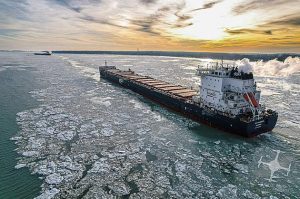SAULT STE. MARIE, Mich. (Michigan News Source) – Thanks to monies authorized in the 2023 National Defense Authorization Act (NDAA), the Coast Guard will have a new tool in their arsenal to break up ice dams in the Great Lakes and surrounding Michigan waterways. $350 million from the bill is for a measure called the “Great Lakes Winter Commerce Act” and will be will be used for a new heavy icebreaker for the Great Lakes.
In the description of the Great Lakes Winter Commerce Act presented by Senators Tammy Baldwin and Todd Young, it says the act will update “outdated Coast Guard’s Great Lakes icebreaking mission and increase the icebreaking capacity of the Great Lakes fleet. Icebreaking is critical for commerce in the Great Lakes and increasing icebreaking capacity to meet the actual need will help the many businesses and workers that rely on he maritime industry to ship their goods.”
MORE NEWS: Judge to Whitmer: Michigan Can’t Pull Plug on Line 5
It reports that 28% of our nation’s GDP is generated in the Great Lakes region, including the bulk of U.S. integrated steel manufacturing and that Great Lakes commerce has suffered in recent years due to insufficient icebreaking during the winter season.
The report goes on to say, “According to the Lake Carriers’ Association, vessel delays due to lack of icebreaking in the 2018-2019 winter season alone cost business that depend on the region’s maritime industry $1.04 billion in lost revenues from an estimated loss of the equivalent of 21 shiploads of coal and 860 shiploads of iron ore. These economic losses resulted in the loss of 5,421 jobs dependent on the U.S. flagged fleet’s ability to deliver cargo throughout the Great Lakes Region. Similar problems occurred during the 2013-2014 and 2014-2015 winters…The need to safeguard the viability of these shipping lanes cannot be exaggerated. Annually, U.S. Great Lakes waterborne commerce supports more than 147,000 jobs in eight Great Lakes states, $20.3 billion in business revenue, $10.5 billion in wages, and $4.6 billion in federal and state taxes.”
In order to continue commerce on the Great Lakes in Michigan, icebreakers have to be used in the winter months to keep shipping lanes open for the approximately 90 tons of cargo goes through the Great Lakes every year. That cargo includes fuel and oil, coal, limestone, iron ore, salt, grain, and other cargo like wind turbine blades.
Wisconsin’s U.S. Senator Tammy Baldwin had spearheaded the commerce act through Congress and told the Milwaukee Journal Sentinel that an additional icebreaker was needed to keep commerce going. She said, “The consequences when we cannot keep up with that icebreaking mission are pretty dire.” Baldwin got assistance with moving the commerce act along with Republican U.S. Rep Mike Gallagher, Republican Indiana Senator Todd Young and Democratic Michigan Senator Gary Peters.
Baldwin continued, “I think a lot of folks don’t recognize how much of our commerce is conducted over water…so the investments that we make…are hugely important.”
Great Lakes Maritime Task Force President Jim Weakley, who is also president of the Lake Carriers’ Association, which represents the Great Lakes shipping industry, said in a statement, “This is a big win for the 4th Sea Coast. Finally, there is recognition that the USCG is not adequately resourced to facilitate critical winter navigation on the Great Lakes. The North American economy and our national security are dependent on the raw materials, like iron ore, that need to move effectively to maintain the nation’s steel production.”
MORE NEWS: Michigan Sitting Out Domestic Oil Boom In US
According to Michigan Radio, icebreaking operations were already started at the end of December. The U.S. Coast Guard launched “Operation Coal Shovel” last week. They reported it as the “yearly effort to break up ice throughout much of the Great Lakes so shipping traffic can continue through the winter months.”
This operation is done jointly with the Canadian Coast Guard and spans from southern Lake Huron to Lake St. Clair, to the St. Clair/Detroit River system, and into Lake Erie and Lake Ontario including the St. Lawrence Seaway.
This year’s operation, which usually starts in January, kicked off a little sooner because of the earlier winter storm at the end of 2022. Icebreakers open the waters for ship traffic but are also used to open channels for icebound island communities so that food, heating oil and other supplies can get through on ferries. Icebreakers also assist with flood control when ice jams form and block water from flowing into lakes, causing flooding. They do this at the request of the U.S. Army Corps of Engineers.
Progress of Operation Coal Shovel can be followed on the Facebook page of U.S. Coast Guard Sector Detroit here.
In all, the U.S. and Canadian Coast Guards have 11 ice breakers (nine of which are owned by the United States) although not all of them are used for Operation Coal Shovel.
The “Mackinaw,” a 240-foot-vessel, is the only “heavy” icebreaker in the fleet with capability of leaving a large enough path for the really large freighters to pass through the waters. The new icebreaker will be very similar to that size.
The Mackinaw, which is one of the biggest icebreakers in the world and is 58 feet wide, is stationed in Cheboygan and can be seen and toured in the summer at Grand Haven’s Coast Guard Festival. It was featured on the TV series, Modern Marvels. In July 2022, CDR Jeannette Greene assumed command of the vessel. The Mackinaw was also used to transport Christmas trees from a tree farm in Michigan’s Upper Peninsula to Chicago residents back in early December.

If you’d like to see some great video of the CGC Neah Bay escorting that convoy down the Detroit River into Lake Erie, go to Matt Zytkowicz’s Facebook page here. Zytkowicz with Erie Sky Photography is a retired Coast Guard warrant officer. He said that he was on the Mackinaw and the Bristol Bay and loved them both.
